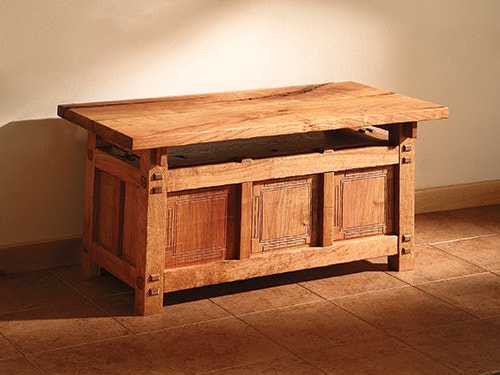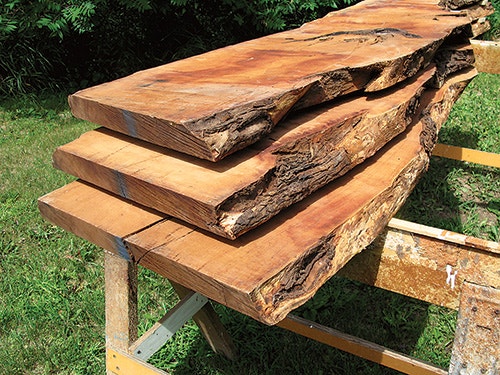Mesquite: Prosopis glandulosa
I have to admit that, previous to building the chest project shown below my most intimate experience with mesquite was pulling its nasty little spikes out of various and sundry sections of my anatomy while bird hunting in Texas. Beyond that, it was most familiar to me as a complement to the barbecue briquettes over which I prepared the fruits of my outdoor labor.
But mesquite, as I was to learn, can be quite impressive lumber! When finished with a clear urethane topcoat, it has a warm brown-orange and red hue with amber flecking. The figure can be downright stunning, too.
Mesquite commonly has many black knot and limbwood incursions. To some degree, these incursion flaws and waney edges are impossible to avoid in this special lumber. But they should be considered beauty marks that add to this rugged wood's distinctiveness.
The lumber is strong, hard, straight-grained and warp-resistant. It has a very low volumetric shrinkage from when it's freshly cut to dry (just 4 to 5 percent).
Honey Mesquite

The most widespread of some 35 species of mesquite in North America is honey mesquite. It occurs from Kansas down through west Oklahoma, most of Texas and into northern Mexico. A variety is found as far west as southern California.
Native Americans used honey mesquite for fuel wood. They commonly used the bean-like fruit, ground into flour, for making a type of bread that was the main staple of their diet. The pods were also used to make drinks. These bean pods are an important food source for numerous species of birds, mammals and livestock.
Mesquite is more widespread now than it was in the 19th century. The introduction of European cattle to the Southwest led to overgrazing of the rangeland, which eliminated the range fires that held mesquite in check. The cattle also widely distributed undigested seed. Interestingly, its range into Oklahoma and Kansas, as well as east into Shreveport, Louisiana, is generally along the trails used for the last 19th century cattle drives out of Texas. It soon took over rangelands under these conditions, eliminating native grass stands.
Lumber Tree Location
While often limited to gnarly, small bushes in extremely dry areas, under ideal conditions, honey mesquite can grow up to 40 feet tall. Straight-stemmed trees, found mostly along damp drainages, are the form most often used for lumber.
The current rate of use of straight-stemmed mesquite for lumber cannot be maintained without good land management practices. Fortunately, land owners in some parts of Texas are now managing stands of mesquite for lumber production.
Shop Score Card
|
Uses: Fence posts and columns, flooring, rustic or fine furniture, millwork, turnings, cabinetry. Hardness: Mesquite ranks higher on the Janka hardness scale than hickory or hard maple. It’s similar in density to red oak but heavier . Country of Origin: Southwestern U.S. into Mexico. Workability: Planes, cuts, routs and drills moderately easily with power tools. Also can be chiseled and carved with sharp hand tools. Finishing: Readily accepts common topcoats without special finishing considerations. Cost: Expensive, given limited availability relative to other more plentiful native hardwoods. |
Keep the inspiration coming!
Subscribe to our newsletter for more woodworking tips and tricks





